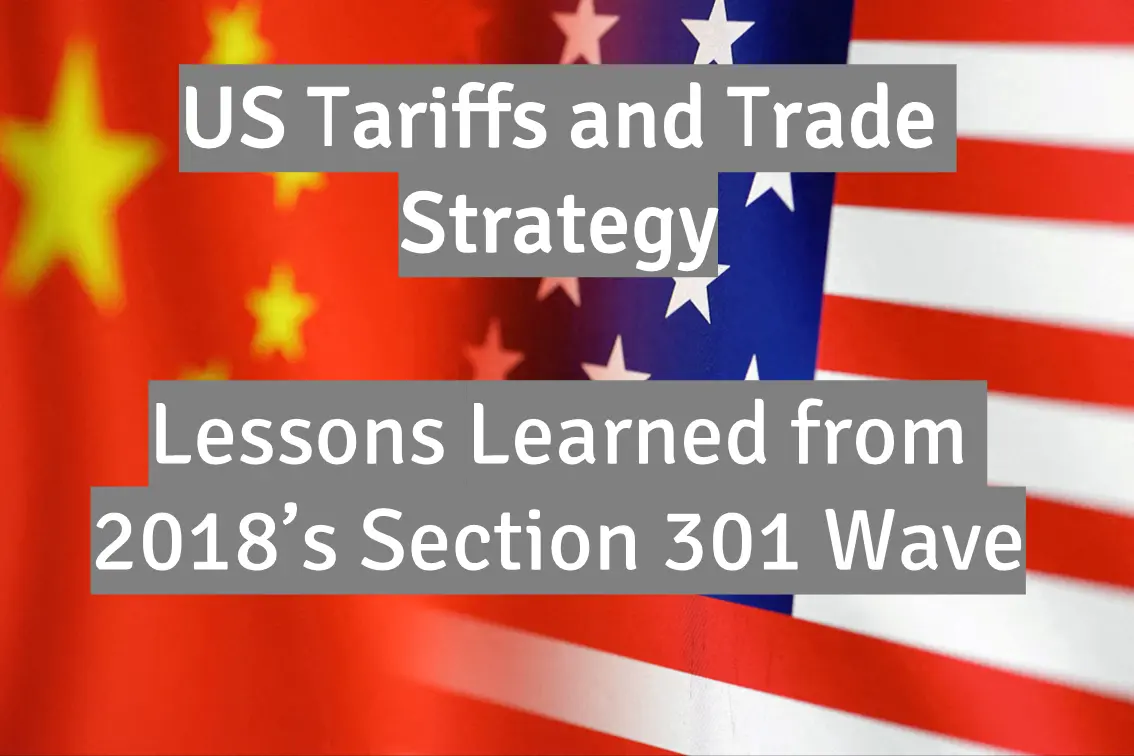The Lasting Impact of Trump’s 2018 Section 301 Tariffs: Lessons for US Supply Chains and Importers

In 2018, the United States shook global trade by imposing sweeping Section 301 tariffs on Chinese imports, triggering one of the most significant shifts in supply chain strategies and import practices of recent decades. As new reciprocal tariff rates take effect and the de minimis rule faces suspension at the end of this month, there’s urgent value in revisiting the repercussions of those initial Section 301 measures—their economic impact, how importers adapted, the role of “first sale” valuation, and the escalation of enforcement efforts by U.S. Customs and Border Protection (CBP). Understanding these lessons from the past is crucial for businesses now charting their course in another phase of intensified trade conflict.
What Happened in 2018: The Section 301 Tariff Shock
The first wave of Section 301 tariffs went into effect on July 6, 2018 as a direct response to China’s alleged unfair trade practices—including forced technology transfers and intellectual property theft. Initially targeting $34 billion in Chinese goods, the measures quickly expanded in further rounds, ultimately reaching hundreds of billions of dollars across multiple tranches, with tariff rates ranging from 10% to 25% on affected products1. The industries impacted were diverse, from electronics to machinery and consumer goods, and almost half of all US tariff lines were eventually covered by some level of additional duty2.
Supply Chain Impacts: The Rush to Reshore and Nearshore
Reshoring and Nearshoring Efforts
Companies accelerated efforts to relocate manufacturing closer to the U.S., either by bringing production back stateside (reshoring) or moving it to nearby countries like Mexico (nearshoring)3. Mexico, benefiting from the United States–Mexico–Canada Agreement (USMCA) and geographic proximity, became a leading partner for nearshoring, particularly in sectors such as automotive, electronics, and textiles4. This shift was motivated by a combination of the desire to avoid tariffs and increasing logistics costs and time delays associated with Asian suppliers. Concurrently, the “China + 1” strategy gained traction; U.S. firms diversified their supplier base by adding partners in Vietnam, India, and other countries to reduce overexposure to Chinese-sourced goods. For example, Vietnam’s exports of footwear—a sector heavily targeted by tariffs—rose significantly during this period5.
Challenges in Supply Chain Diversification
Despite the incentives, relocating production was rarely smooth or costless. Companies faced considerable challenges with onboarding new suppliers, maintaining quality control, and managing the geopolitical and regulatory risks inherent in these newly diversified networks6. The rush to “beat the tariffs” caused port congestion as importers accelerated shipments ahead of deadlines, which, in turn, drove up warehousing costs7.
Limited Growth in Domestic Manufacturing
While the administration’s policy rationale favored boosting U.S. manufacturing, evidence shows that domestic production growth was modest and often overshadowed by the redirection of imports to low-cost countries other than China. For instance, U.S. “cut and sew” apparel manufacturing increased by just 6.3% over one year, whereas imports from third countries rose by as much as 25% during the same period8.
Use of “First Sale” Valuation or Under-Valuation Tactics
In order to mitigate the increased tariff burden, importers increasingly leveraged the “first sale” rule. This valuation method allows duties—including Section 301 tariffs—to be calculated based on the price paid in the earliest bona fide sale (such as the manufacturer to a middleman), rather than the final price to the U.S. importer9. This approach can substantially reduce the declared customs value and thus the tariff liability.
The use of the first sale rule surged after 2018 as importers sought lawful means to lower their tariff exposure10. However, this method necessitates meticulous documentation demonstrating the legitimacy and arm’s-length nature of each transaction. Validation becomes especially complex for goods originating from “non-market economies” like China, where customs authorities intensified scrutiny910. No clear evidence has emerged indicating widespread under-valuation or fraud, but the increased complexity inevitably created legal gray areas and led to more audits and disputes.
CBP’s Increased Enforcement on Valuation and Origin
Faced with the surge of tariffs and the risks of evasion, U.S. Customs and Border Protection (CBP) intensified its oversight activities. Audits, reviews, and penalties focusing on accurate product valuation and country of origin declarations increased significantly11. Historical data shows a continuous rise in audits and trade penalties since the inception of Section 301 tariffs, with duties assessed from China alone reaching nearly $50 billion annually at the peak11. CBP also increased enforcement on circumvention concerns, including assembly shifting, transshipment via third countries, and misdeclaration of origin12. Special attention was paid to evaluating claims of “substantial transformation” for goods processed in third countries to determine whether qualifying changes in origin exempted products from 301 tariffs13.
Strategies Deployed by US Importers to Manage Tariff Impact
In response to these challenges, importers employed various strategies to reduce or defer tariff costs. Companies restructured their bills of material, increasing U.S.-origin content and scrutinizing country of origin claims to benefit from exclusions or apply lower tariff classifications14. Firms with substantial re-export volumes utilized the U.S. duty drawback program to reclaim duties paid on products subsequently exported, although eligibility for refunds varied15. Additionally, businesses engaged in tariff engineering by modifying products slightly to fit into non-tariffed classification categories16. The use of Free Trade Zones (FTZs) and bonded warehouses allowed some companies to defer tariffs or avoid them entirely when goods were re-exported without entering U.S. commerce17. Lobbying efforts also intensified, resulting in a flood of product exclusion requests submitted to the USTR. While some exclusions provided temporary relief, these were often narrow and time-limited18. Importantly, CBP maintained a strict stance on tariff circumvention; if light assembly in a third country fell short of a “substantial transformation,” Section 301 tariffs still applied13.
Key Takeaways for Today’s Importers
The legacy of the 2018 Section 301 tariffs offers several critical lessons for businesses navigating today’s renewed trade challenges. First, transitioning supply chains—whether by reshoring or nearshoring—is neither quick nor straightforward and demands substantial investment in partnerships, compliance, and logistics. Second, every approach to valuation, origin confirmation, and classification must withstand enhanced CBP scrutiny, making thorough documentation indispensable. Third, depending exclusively on tariff exclusions or carve-outs is precarious given their potential revocation amid shifting policy dynamics. Fourth, importers should maximize legally available duty mitigation tools such as FTZs and duty drawback programs, but expect heightened paperwork and compliance burdens. Finally, maintaining supply chain transparency—from raw materials through final assembly—is not merely advisable but essential for survival amid evolving trade enforcement.
Conclusion
The 2018 Section 301 tariffs represent a pivotal moment in U.S. trade policy, driving a broad and costly reconfiguration of global sourcing patterns toward nearshoring and supply chain diversification rather than a transformative resurgence in domestic manufacturing. The resulting complexity in compliance, valuation, and origin determination prompted an enforcement increase by CBP to ensure trade integrity across an increasingly layered supply chain. Importers that succeeded amidst these changes combined strategic sourcing, meticulous compliance, financial analysis, and active engagement in policymaking. As new reciprocal tariffs and changes to the de minimis rule come into effect, these lessons and tactical approaches remain highly relevant for businesses contending with continuing trade tensions.
References
The TDR experts team is ready to support validating your options to mitigate the new US tariffs impact. Contact us today or visit our page dedicated to trade consulting.
-
Office of the United States Trade Representative (USTR) 301 Reports (2018–2020) ↩
-
Financial Times, “US manufacturers accelerate ‘reshoring’ after tariffs on Chinese imports” (2019) ↩
-
Kearney, “Reshoring Index 2020: Tariffs and COVID-19 Accelerate Manufacturing Return” ↩
-
Forbes, “Mexico Emerges As Winner From U.S.-China Trade War” (2019); McKinsey & Company, “Nearshoring in the Americas: Time for action” (2020) ↩
-
Wall Street Journal, “Trade War Spurs Companies to Diversify Supply Chains Away From China” (2019); Bloomberg, “Vietnam Gains From Trade War” (2019) ↩
-
Wall Street Journal, “Trade War Spurs Companies to Diversify Supply Chains Away From China” (2019) ↩
-
Journal of Commerce, “Port Congestion Mounts as Importers Beat Tariff Deadline” (2018) ↩
-
US Census Bureau, “Annual Survey of Manufactures” (2018–2019); Brookings Institution, “Did Trump’s tariffs help American workers?” (2020) ↩
-
International Trade Today, “First Sale for Export: Many Importers Take Another Look Post-301 Tariffs” (2019); Sandler, Travis & Rosenberg, “First Sale for Export: Benefits, Risks and Compliance” (2019) ↩ ↩2
-
U.S. Customs and Border Protection, “First Sale Declaration Requirement Guidance” (2019) ↩ ↩2
-
U.S. Customs and Border Protection, “Trade and Travel Report: Fiscal Year 2019”; Government Accountability Office (GAO), “CBP Should Take Additional Steps to Strengthen the Audit Process” (2021) ↩ ↩2
-
Reuters, “US customs targets China tariff dodgers by checking ship origins” (2019); U.S. Customs and Border Protection, “Determining Country of Origin of Goods Imported into the United States” (HQ rulings, 2018–2020) ↩
-
U.S. Customs and Border Protection, HQ rulings and press releases, 2018–2021 ↩ ↩2
-
KPMG, “US Tariffs: Mitigation and Planning Strategies” (2019) ↩
-
U.S. Customs and Border Protection, “Modernized Drawback Final Rule” (2018); Journal of Commerce, “Exporters turn to duty drawback as tariffs bite” (2019) ↩
-
The Wall Street Journal, “How US Importers Are Tweaking Products to Dodge Tariffs” (2019) ↩
-
KPMG, “US Tariffs: Mitigation and Planning Strategies” (2019) ↩
-
Office of the United States Trade Representative (USTR), “Section 301 Exclusion Requests and Determinations”; CBP Press Releases, “CBP Targets 301 Tariff Evasion” (2019–2021) ↩
